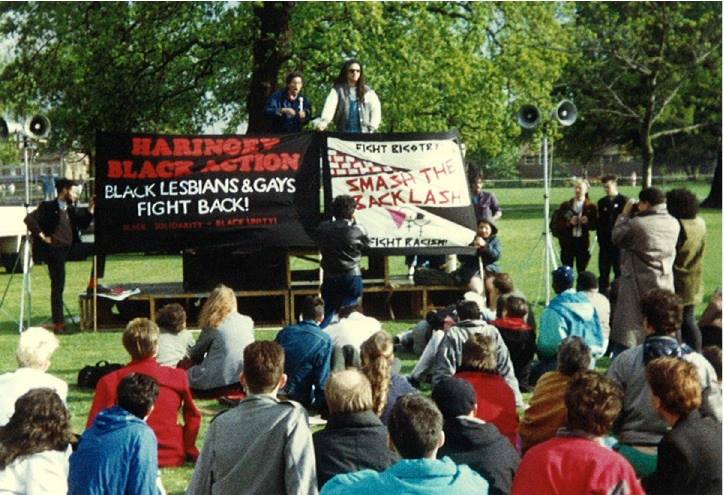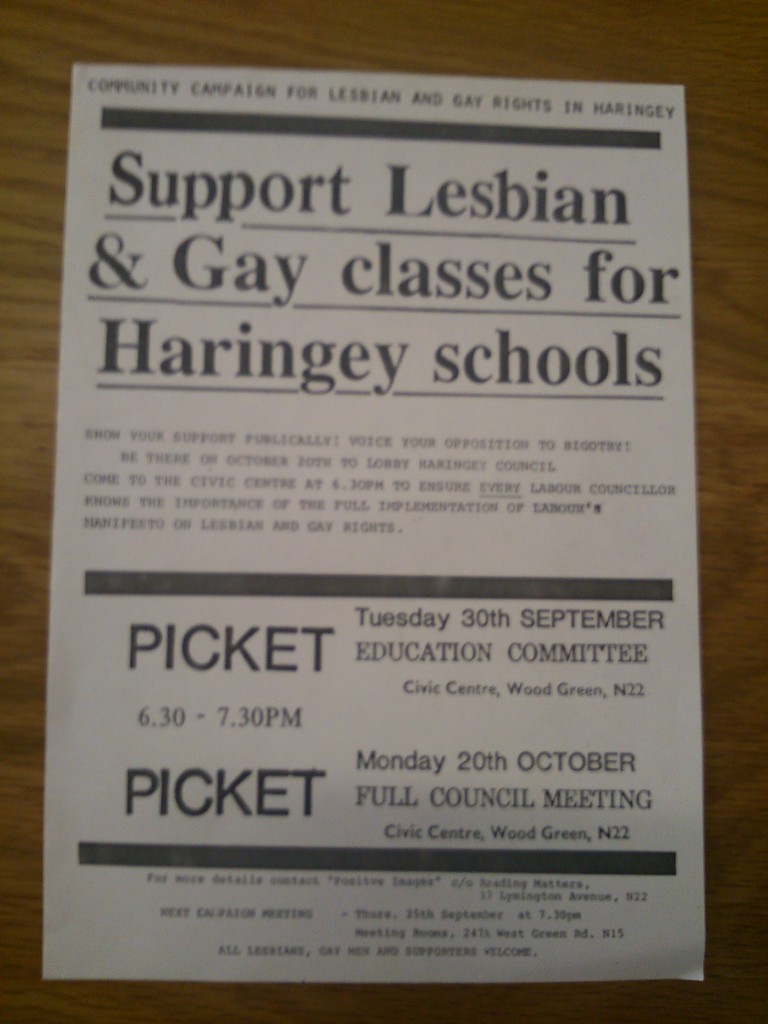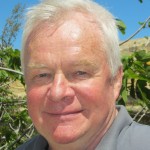Who is going to take responsibility for researching the sexual politics of Haringey in the 1980s? Haringey is a multicultural North London borough with a population of around a quarter of a million, and major economic contrasts between different localities; it includes Broadwater Farm estate, which was the scene of major riots in 1985. Its policies in the 1980s that related to lesbians and gay men were part of a broader commitment by the council to equal opportunities. By going into previously unexplored territory, Haringey raised all kinds of questions about civic responsibility towards stigmatised sexual minorities, the involvement of such minorities in the development of these policies, the tensions between liberationist politics and social democratic politics, the political management of negative responses to these policies and also strategies for coalition building.
The Haringey story has the potential to be a case study of a historically significant moment for modern sexual politics. Haringey Council’s commitment to support lesbians and gay men in the 1980s brought it into the eye of a storm that had long-term repercussions for engaging with how young people learn about sexuality in the public arena. As someone who helped design these policies, who took on a representational role and who campaigned against the backlash, I do not pretend to be taking an objective view. I am flagging up issues which take this beyond a story of local interest to something that is more universally significant. This post should be read as a call to potential researchers.

Lesbian and gay equality, despite considerable levels of anti-AIDS prejudice at the time, featured in the manifesto of the Labour Party when it won control of Haringey Council in May 1986. The policy was not just asking the world to be nice to a stigmatised group; it was located within a framework of understanding and challenging heterosexism. Heterosexism was defined as a system of ideas and practices based on a set of beliefs about heterosexuality being the single normal and natural sexuality for both women and men. For those engaged in sexual politics and equality politics, this was the latest stage of development in debates which had been ongoing since the establishment of the Gay Liberation Front and other social movements in the 1970s. How do you interpret the structural position of sexuality within society? How does a council ensure that its services are shaped by a commitment to oppose heterosexism? How do children learn about the social construction of sexuality? These were, however, debates which were easy to misrepresent. Could Haringey Council, as some of its opponents suggested, really be challenging the existence of heterosexuality?
Within weeks of Labour taking office, the opposition to these anti-heterosexist policies focused on the opportunity for young people to learn about the experiences of lesbians and gay men. A group called the Parents Rights Group was set up to resist this policy and made alliances with some of the more conservative religious groupings in the borough. The council’s policies were supported by a community organisation which took the name of Positive Images. A Conservative councillor, Peter Murphy, proposed a motion for a council meeting in October 1986 which stated: ‘This council resolves that it will not allow teaching of homosexual or lesbian education in Haringey Schools and will permit parents to remove children from sex education lessons’. The motion was defeated but the campaigns around it were based in local communities as much as (or more than) they were based in the council chamber.
The Conservative Government also began to take a close interest in the educational policies of this one London council; I doubt that the other one hundred and seventy education authorities in England and Wales received such direct, precise attention. Correspondence between the council’s education team and the Department of Education and Science (DES) identified particular worries about the establishment of a curriculum working party to establish guidelines for “anti-heterosexist” (DES’s inverted commas) approaches to education. As early as 29 January 1987, the DES was expressing concern about ‘the promotion of homosexuality’. Without adopting a conspiracy theory viewpoint, it is easy to see that the groundwork was being laid (intentionally or otherwise) for the introduction of legislation to inhibit the right of school students to learn about the diversity of sexualities. The following year, Clause 28 of the Local Government Act (1988) forbade councils from undertaking ‘the promotion of homosexuality’, and even today politicians across the world use that same phrase to denote their opposition to an acceptance of non-heterosexual aspirations.

The atmosphere in Haringey became particularly fraught, with claim and counterclaim swirling around the significance of these policies. The Positive Images group was approached by Haringey Black Action, a group which had been campaigning in black communities about lesbian and gay rights. Their working relationship proved to be difficult, particularly in relation to the interaction between issues of racism and the policy regarding learning about sexuality in schools. Nonetheless, a demonstration against bigotry and in defence of lesbian and gay rights was organised by the two groups in May 1987; it was the first UK demonstration to highlight the narratives and aspirations of black lesbians and gay men. It was a well attended, successful demonstration but the central dilemma about racism and heterosexism was never resolved and within weeks the collaboration crumbled away.
The issues raised in Haringey did not go unnoticed, and were the object of debate in journals such as Lesbian and Gay Socialist, Gay Times and Capital Gay. More recently, the municipal delivery of services to lesbians and gay men has been researched by Davina Cooper. The policies that were initiated in Haringey and the responses to them were largely without precedent; there were parallel developments in other councils but few of them engaged with the right to learn about sexuality as fully as Haringey. This has left ample historical material for researchers. There are archival holdings available in local council records, in Bruce Castle Museum, in Hansard, in the Hall Carpenter Archive and in community publications. Many of the stakeholders are still around and interviews with them could form the basis of an exciting oral history project. There are enormous possibilities for academic research into the Haringey experiment and its outcomes; an intersectional perspective would be invaluable. Such a journey into uncharted territory deserves fresh examination.
 Bob Cant has been a teacher, a trade unionist, a community development worker, a Haringey activist and an editor of several collections of LGBT oral history. He now lives in Brighton and his first novel, Something Chronic, was published in October 2013. Bob tweets from @bobchronic.
Bob Cant has been a teacher, a trade unionist, a community development worker, a Haringey activist and an editor of several collections of LGBT oral history. He now lives in Brighton and his first novel, Something Chronic, was published in October 2013. Bob tweets from @bobchronic.

NOTCHES: (re)marks on the history of sexuality is licensed under a Creative Commons Attribution-NonCommercial-NoDerivatives 4.0 International License.
Based on a work at www.notchesblog.com.
For permission to publish any NOTCHES post in whole or in part please contact the editors at NotchesBlog@gmail.com





Bob raises (not for the first time) the important issue of who has, or can take on, responsibility for capturing our history. I did raise this issue at an event that Bob was speaking at in Edinburgh a year or so ago but got mainly puzzled looks – not only was there little appetite for substantial historical work it seemed the fact that we have precious little was of no concern to the majority of the audience supposedly made up of persons with an interest in “lgbt” history.
I am keenly aware that the history of the repeal of Section 28 in Scotland needs to be, and could be, captured and no doubt there are many other examples. Have there been no discussions among lgbtqi historians about organising an association or an annual conference or a journal around which to organise? This forum could help but it seems to function more as a notice board (and that’s great, I’ve learned a lot) rather than being able to facilitate any on-going, organised work. I’d be happy to try to contribute to something if people thought it viable/worthwhile.
Thanks for your comment, Brian. I remember that meeting at the National Library of Scotland very well. I think that one of the things that the Haringey Experiment and the Scottish campaign around the repeal of Section 28/2A have in common is that there is a relatively narrow time frame to focus on. The greater issues – such as heterosexism or attempts to manipulate the democratic process – are still there but the researchers have the opportunity to conduct fieldwork without being overwhelmed by its scale. It’s nearly fifteen years since the Section 28/2A farrago and people may now be ready to talk about their involvement. It’s still a sore issue for many people and great care would need to be taken to ensure that the research process was independent of other influences. I would be happy to offer support to any historical initiative that’s intended to promote reflective historical debate on the evolution of sexual politics in Scotland in relation to Section 28/2A.
Pingback: Whewell’s Gazette: Vol. #26 | Whewell's Ghost
Pingback: Are we seeing a return of Section 28? | Rebel Yarns